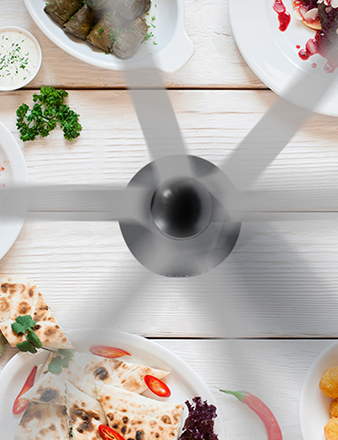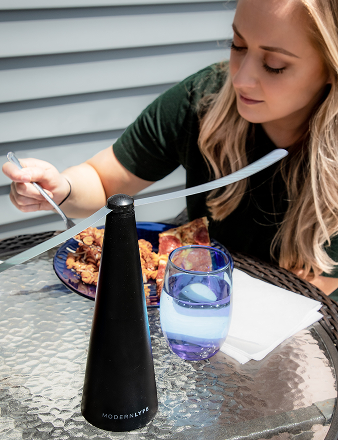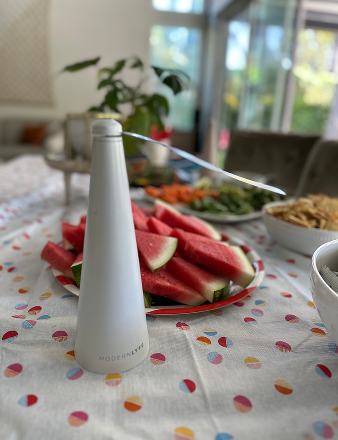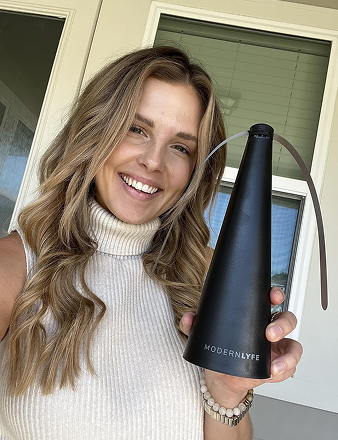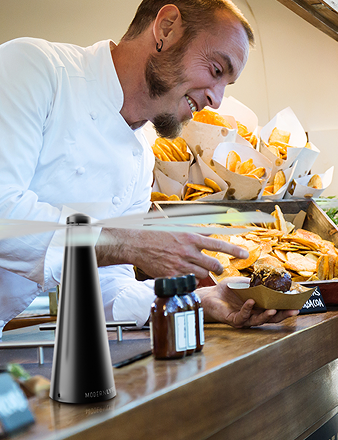Flies can ruin a great meal. Whether you're at a backyard barbecue, managing a restaurant patio, or enjoying a quiet dinner on your deck, buzzing pests are a major annoyance.
Chemical sprays and bug zappers come with their own issues—unpleasant smells, toxins near food, and safety risks. There’s a simpler, more effective way to handle it: the fly repellent fan.
Your Guide to a Fly-Free Zone
A fly repellent fan is a brilliantly simple device. Its soft, rotating blades create a constant, gentle breeze. While barely noticeable to us, it's a disruptive crosswind for a fly, making it nearly impossible for them to land on your table.
Think of it as an invisible shield for your food. Flies can’t see it, but their instincts tell them to stay away.
Why Choose a Fan Over Other Methods?
The best part about a fly fan is its safety and simplicity. Unlike chemical repellents, it introduces no toxins or fumes into your dining space. This makes it the ideal choice for placing directly on a table with food, especially with kids and pets around.
Here’s why they’ve become so popular:
- Chemical-Free: Protect your food and guests without any sprays, lotions, or harsh chemicals.
- Completely Safe: The blades are soft and flexible, designed with a soft-stop feature. If a hand gets in the way, they stop instantly without causing harm.
- Silent Operation: They work quietly in the background, so they won't interrupt conversations or ruin the atmosphere.
This shift toward safer pest control is a growing trend. The global market for fly repellents, valued at USD 4.24 billion in 2025, is projected to reach USD 5.97 billion by 2030. A key driver is integrating repellent tech into everyday devices like fans, a trend you can read about in detailed industry research.
A fly repellent fan isn't just another gadget; it's a modern, effective tool for reclaiming your space. It gives you the peace of mind to focus on what matters—the food, the company, and the conversation—not the flies.
How Fly Repellent Fans Actually Work
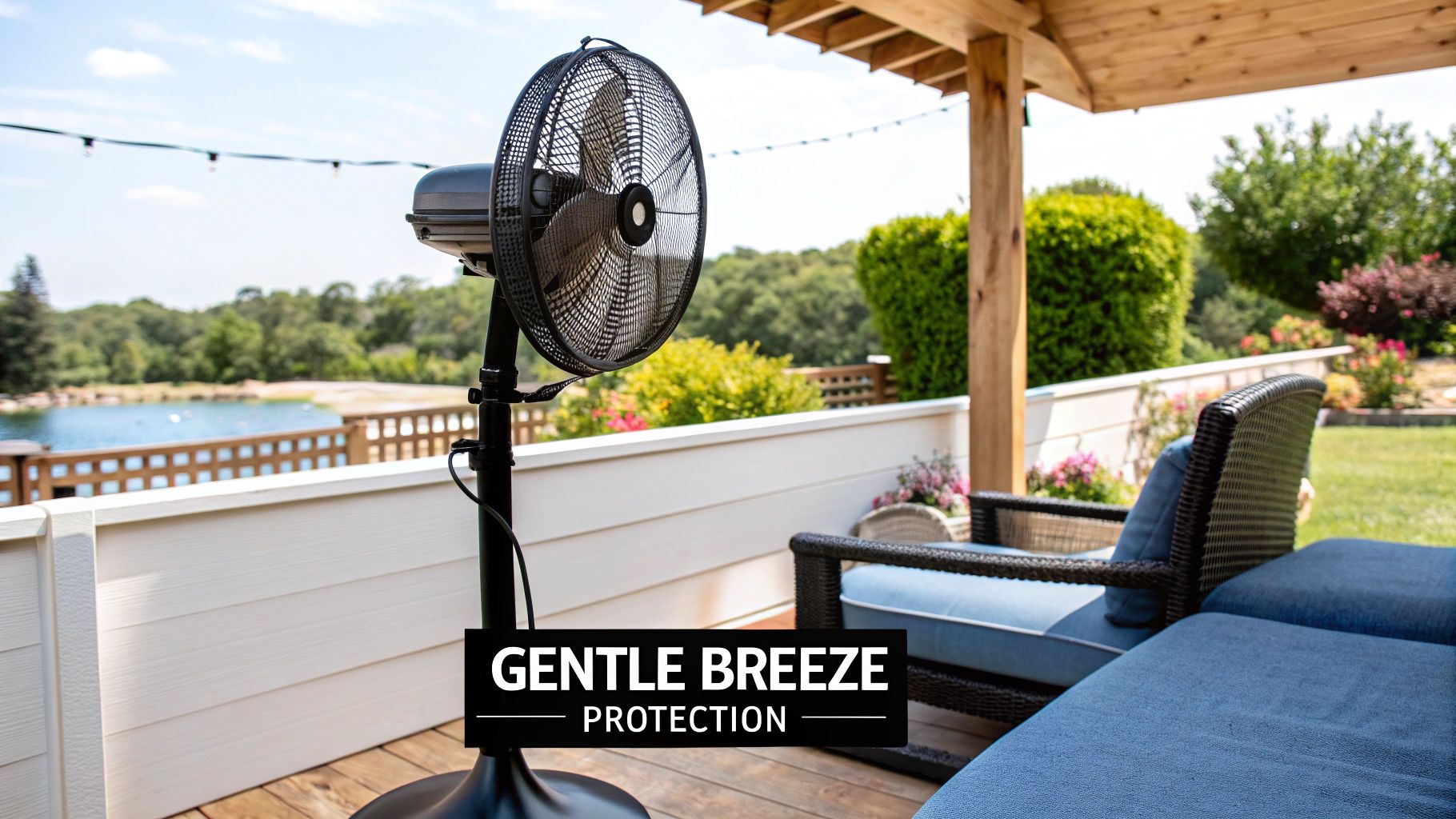
It seems too simple: a small fan on your table keeps every fly away. The secret isn't magic; it's smart engineering that uses a fly's own biology against it. The best fly repellent fans create an invisible, spinning shield that flies simply won't cross.
First, it’s about air movement. The soft blades generate a constant breeze. For a tiny insect like a housefly, this current is like flying into a persistent headwind. It makes navigation unpredictable and landing on your food a major challenge, creating a "no-fly zone."
Think of it as a silent, invisible bouncer for your table—a physical barrier that works tirelessly without disturbing your meal.
Disrupting a Fly's Vision
Here’s where it gets smarter. Beyond just pushing air, the most effective fans add a visual deterrent. This is why you see shiny, holographic patterns on the blades.
Flies have compound eyes, incredible structures made of thousands of tiny lenses. While this makes them hyper-sensitive to light and motion, it also means they see the world as a mosaic of fractured images.
When the fan's reflective blades spin, they catch and bend light, creating a chaotic, shimmering effect. To a fly's brain, this isn't a pretty pattern—it's an alarming and unpredictable visual threat. Its survival instincts kick in, interpreting the distorted light as a large, dangerous object to be avoided.
This one-two punch of air disturbance and visual confusion makes these fans so effective. They attack a fly’s ability to navigate and its perception of safety, all without chemicals or smells.
The result is a simple, safe, and highly effective way to protect your space. Once you understand how these two principles work together, it's clear why this technology is a go-to solution for everything from restaurant patios to backyard cookouts.
What Makes a Fly Repellent Fan Truly Great?
When shopping for a fly repellent fan, many models look alike, but the features that matter are in the details. A great fan isn't just another gadget; it's an essential tool for a peaceful, fly-free meal.
Let's break down what really counts.
Safety First: Soft-Stop Blades are Non-Negotiable
The single most important feature is soft-stop safety blades, especially with kids or pets around. These aren't rigid fan blades. They are flexible and stop instantly the moment they touch something, like a hand reaching for food. This makes them completely safe to use around everyone, offering peace of mind you don't get with other solutions.
Powering Your Pest-Free Zone
How you power your fan dictates its convenience and where you can use it. Consider this upfront to pick a model that fits your lifestyle.
- Battery-Operated: The classic, go-anywhere option. Perfect for picnics, camping, or any spot without an electrical outlet. Just keep spare batteries on hand.
- Rechargeable (USB-C): A modern, sustainable choice. These fans have a built-in rechargeable battery, usually powered by a standard USB-C cable. Charge it from a power bank, laptop, or wall adapter—no more hunting for AA batteries.
- Hybrid Models: The best of both worlds. These versatile fans can run on disposable batteries, plug into a USB power source, or use an internal rechargeable battery, ensuring your fan is always ready.
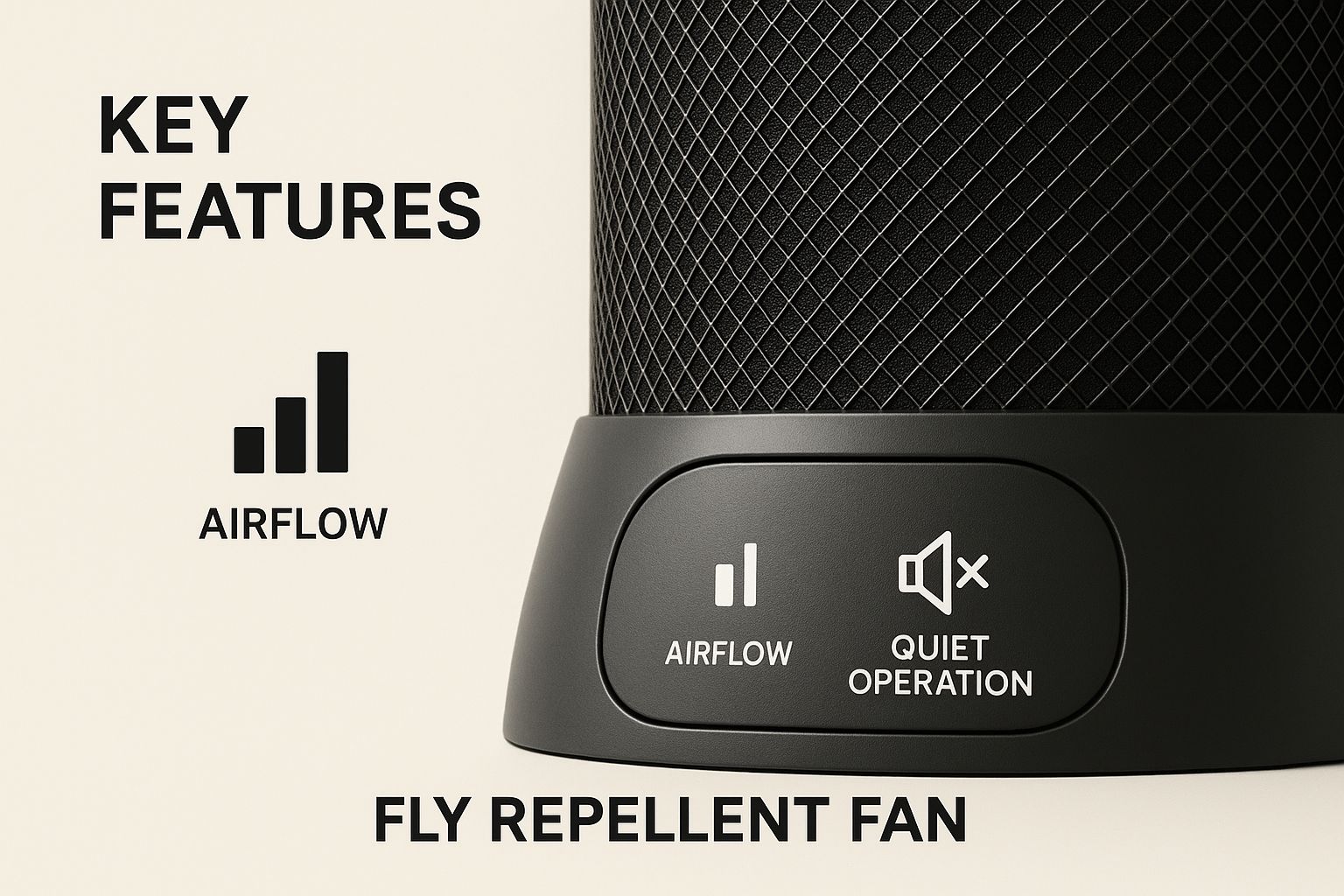
This image highlights other key operational features, like whisper-quiet motors and effective airflow, that separate a quality fan from a cheap imitation.
Fly Repellent Fan Feature Comparison
This table breaks down the essential features to look for, helping you quickly compare what matters most for your situation.
| Feature | What to Look For | Best For | Potential Drawback |
|---|---|---|---|
| Safety Blades | Soft, flexible blades that stop on contact. | Homes with children and pets; busy social gatherings. | Not applicable; this is a must-have feature. |
| Power Source | Battery-operated, USB-C rechargeable, or a hybrid of both. | Battery for portability; rechargeable for sustainability. | Battery models require replacements; USB models need a source. |
| Blade Length | Longer blades for wider reach. Look for specific coverage radius in descriptions. | Larger tables or buffet setups. | Might be overkill for a small bistro table. |
| Portability | Lightweight, compact design. Bonus points for a hanging hook on the base. | Picnics, camping, travel, and moving between indoor/outdoor spaces. | Ultra-compact models may have a smaller coverage area. |
Your perfect fan will check the boxes that align with how you plan to use it. A model like the Modernlyfe Fly Fan is a great example of a fan that balances these features effectively.
Finding the Right Size and Reach
The fan's physical design is as important as its power source. Blade length, for instance, directly dictates its coverage area. Longer blades push more air, creating a larger fly-free zone. A typical fan protects a 3-4 foot radius, usually enough for a standard four-person table.
For a large rectangular patio table or a buffet, use two or three fans strategically placed to create an overlapping, impenetrable barrier.
Portability is the other key factor. A fan should be lightweight and compact enough to toss in a bag. The smartest designs include a hook on the base, letting you hang the fan upside down from an umbrella, pergola, or tent for excellent overhead coverage.
It's clear people are catching on. In 2025, we've seen a 15% jump in searches for outdoor-specific fly fans, showing a real shift toward durable, portable solutions. By keeping these core features in mind, you'll find a fan that gets the job done.
Top Fly Repellent Fan Models for Any Situation

Now that you know what makes these gadgets work, let's get practical. The key is picking the right fan for the right job. A model that’s great on a kitchen counter might be overwhelmed on a restaurant patio.
Here’s a breakdown of the best options based on how you'll use them.
The Workhorse: For Large Patios and Buffets
For a big outdoor dining table or a bustling patio, you need maximum coverage. The goal is to create an overlapping zone of protection with no weak spots. This is where you bring in models with a sturdy base and longer blades.
Look for a fan that can protect a 4-foot radius. For a standard rectangular table seating six to eight people, use two of these fans—one at each end. This creates a powerful, unbroken barrier that flies won't cross.
- Pros: Maximum coverage and durable materials for outdoor use.
- Cons: Bigger and less portable, requiring more storage space.
Expert Tip: Don't rely on a single fan to protect a large area. Two well-placed fans creating overlapping air currents is the secret to a truly fly-free zone.
The Portable Pick: For Picnics and Outings
If you’re on the go—heading to a park, campsite, or the beach—portability is king. The best fan for these adventures is lightweight, compact, and ready for action.
Your must-haves are battery operation or, even better, a USB-rechargeable battery. A game-changing feature is a hook built into the base. This lets you hang the fan from an umbrella, tent pole, or branch for excellent overhead protection.
- Pros: Super lightweight, easy to pack, and versatile for any location.
- Cons: Smaller blades mean a tighter coverage area, usually best for two to four people.
For this kind of flexibility, it helps to see different designs side-by-side. You can check out a great range of portable styles and features in Modern Lyfe's fly fan collection.
The Stylish Choice: For Kitchens and Indoor Gatherings
Inside the home, aesthetics matter. For a kitchen island, breakfast nook, or indoor party, you need a fan that works well without looking out of place. These models offer sleek designs, often in finishes like matte black, white, or brushed metallic tones to complement your decor.
While they work like their portable cousins, the focus is on a polished look and, crucially, quiet operation. The last thing you want is a noisy gadget during a family dinner.
- Pros: Beautiful designs that blend in, whisper-quiet motors, and a small footprint.
- Cons: Not as rugged as patio models, so they're best kept indoors.
Ultimately, picking the perfect fly repellent fan is about matching its strengths to your specific space and needs.
Placing Your Fan for Maximum Fly Protection
Having a great fly repellent fan is half the battle; where you put it makes all the difference. Proper placement turns your fan from a simple gadget into an invisible shield for your food.
The fan's blades create a protective bubble of moving air, a "no-fly zone" extending about three to four feet out from the center. Your goal is to ensure this bubble covers every plate and platter on your table.
The Rule of Thumb for Coverage
Getting placement right is simple once you know the basics.
- Small Round Table (2-4 People): One fan in the middle is perfect, creating a 360-degree barrier.
- Rectangular Table (6-8 People): A single fan will leave the ends vulnerable. Use two fans, one at each end, to create an overlapping current of air down the entire length.
- Long Buffet Line: For large parties, plan on one fan for every three to four feet. Spacing them evenly ensures there are no weak spots for flies to get through.
These fans are becoming more popular for a reason. Global import data shows a 35% increase in fly repellent shipments in the last year, with products now in over 90 countries. It's a clear sign that people everywhere want better ways to deal with pests. You can see more details about this market growth on Volza.com.
Advanced Placement Tricks for a Perfect Barrier
Once you have the basics down, a few pro tricks can boost your fan's performance.
The goal isn't just to disrupt flies but to create an environment where they feel completely unwelcome. By controlling the airflow, you control the space.
If your fan has a hook on the bottom, hang it upside down from a patio umbrella or pergola. This creates a top-down cone of air that blankets the whole table, offering even better coverage.
Also, pay attention to the wind. Position your fan so its airflow works with the natural breeze, not against it, to extend its protective reach. Smart placement is a crucial part of our comprehensive guide on how to keep flies away from food. When you combine a quality fan with these strategies, you create a relaxing, pest-free zone.
Answering Your Questions About Fly Repellent Fans
It's smart to have questions before buying a new device. Here are answers to the most common ones, so you can feel confident in your choice.
Are They Safe to Use Around Kids and Pets?
Yes, absolutely. Safety is a core design feature and a top reason people choose them over chemical sprays.
Reputable fly fans use soft, flexible blades with a built-in soft-stop feature. If a curious hand or snout gets in the way, the blades stop instantly without causing harm, giving you peace of mind that other methods can't match.
Do They Work on Mosquitoes, Too?
They can help, but they aren't a dedicated mosquito solution. A fly fan's main job is to deter flies, but the constant breeze also makes it difficult for other weak fliers like gnats and some mosquitoes to navigate.
Think of it as a bonus. For serious mosquito problems, pair your fly fan with a dedicated solution like citronella candles or a mosquito trap for the best results.
A fly fan makes the air a challenge for small insects to fly through. While built for flies, you'll likely see fewer gnats and other tiny pests as a happy side effect.
How Many Fans Should I Get for My Table?
This depends entirely on the size of your space. A single, standard-sized fan works great for a typical four-person round table, covering a radius of about three to four feet.
For larger areas, you'll want to scale up.
- For a rectangular table (6-8 people): Place two fans at either end. This creates an overlapping "no-fly zone" that covers everyone.
- For a long buffet table: A good rule is to place one fan every three to four feet to ensure the entire spread stays protected.
What’s Involved in Taking Care of the Fan?
Maintenance is incredibly simple. The most important task is to occasionally wipe the holographic blades with a soft, damp cloth.
Dust and fingerprints can dull the reflective surface, making it less effective at disorienting flies. Keeping the blades clean and shiny is key. For battery-powered models, use good-quality batteries for reliable performance. When you're done, bring it inside to protect the motor from rain and humidity.
Ready to take back your patio and enjoy your meals in peace? The right fan makes all the difference. Find the perfect combination of style, safety, and performance with a fly repellent fan from MODERN LYFE.
Explore our collection and find your solution at modernlyfe.com

